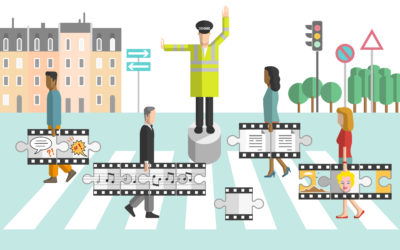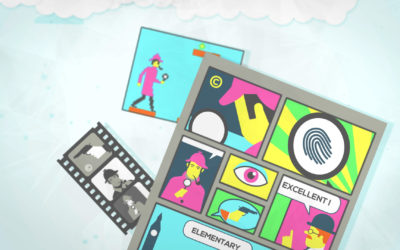Using & Reusing
Author: Bartolomeo Meletti
Illustration: Davide Bonazzi
When creating new work, it is natural to be inspired by the work of others. However, there is an important distinction between simply being inspired and unlawfully copying. In order not to infringe someone else’s copyright – meaning that you trespass on or otherwise interfere with their rights – you need to make sure that your work is substantially different to the work that inspires you. According to UK copyright law, your work is considered original – and thus protected by copyright – if you use your skill, labour, judgement and effort to create it. Using another’s work is copyright infringement when ‘the work as a whole or any substantial part of it’ has been copied. The meaning of ‘substantial’ changes is defined on a case-by-case basis. Usually the court focuses on the quality of the parts taken, not necessarily the amount, and the circumstances of each case.
A recent example is the Da Vinci Code decision. Michael Baigent and Richard Leigh, authors of The Holy Blood and The Holy Grail, claimed that Dan Brown’s novel The Da Vinci Code was an infringement of their copyright. Some historical details contained in their book were alleged to have been copied by Brown without permission. However, the judge, Peter Smith, dismissed their case, stating that elements such as the ‘Grail legacies’ which are historical matters of fact cannot be protected by copyright; it is ‘material well in the public domain’.
A few years later, rightsholders of the book Willy the Wizard sued J. K. Rowling alleging that Harry Potter and the Goblet of Fire infringed their copyright by taking five main plot elements from Willy the Wizard. In this case, Justice Kitchin, following the Da Vinci Code decision, held that ‘the similarities upon which Mr Allen relies seem to me to constitute ideas which are relatively simple and abstract and I strongly incline to the view that they are at such a high level of generality that they fall on the ideas rather than the expression side of the line.’
This is a fundamental principle of copyright law: copyright protects only the expression of ideas, not the ideas themselves. Therefore, if the existence of Willy the Wizard did not prevent J. K. Rowling from writing Harry Potter and the Goblet of Fire, the fact that Harry Potter is copyright protected should not prevent you from writing your own novel about a young wizard. You just need to add your skill, labour, judgement and effort to your story and make it substantially different to J. K. Rowling’s work. However, in some cases – such as two people taking a picture of the same object – the line between ideas and expression of ideas is really hard to define. A recent copyright decision involving two photographs incorporating the same objects can be read here.
In general, if you want to substantially re-use someone else’s work – which includes copying, adapting or sharing it – you need to identify the copyright owners and obtain their permission. This process can be quite difficult at times, especially when dealing with complex copyright works like films.
Here are a couple of important things to remember:
1) Copyright arises automatically; no formalities, such as registration, are required. Because of this, even if there is no © symbol or any copyright information at all attached to the work, the work – unless it is very old – is still likely to be protected.
2) The fact that a work is publicly available – like a picture you find using Google Images search – does not allow you to freely re-use it.
When you purchase something legally – eg. a song from iTunes – you need to check the terms and conditions of the licence in order to know what uses are allowed. This is not easy at all as licences are usually long and technical. In general, most licences do not permit you to re-use the work in new productions. However, there are a few licences like Creative Commons, which explicitly encourage the re-use of work.
Copyright does not last forever. In most countries, such as the UK, copyright expires 70 years after the author’s death. After that, the work is in the public domain, meaning that it can be re-used for free, without the need to ask for permission. So for example, all of Leonardo da Vinci’s paintings as well as all Mozart’s compositions are in the public domain and free to re-use in the production of new work.
There are also other cases in which, under certain conditions, you can re-use the work of others without their permission. These cases are known as copyright exceptions. EU law provides a list of copyright exceptions that can be implemented within Member States. A number of the exceptions implemented in the UK – such as quotation, news reporting, research and private study, and parody – are often referred to as fair dealing exceptions, meaning that in order to benefit from them the copying of the work needs to be fair. How much copying from a work is fair or unfair is an issue ultimately decided by a court of law according to a number of factors, such as the amount of the work taken. More details about fair dealing exceptions can be found in the relevant sections.
When you use someone else’s copyright work in new productions, even though you may be benefitting from a copyright exception in doing so, you should always credit the author of the original work. Some copyright exceptions such as criticism and review explicitly require ‘sufficient acknowledgement’, meaning that you need to identify the creator of the work and the title of the material. It is the author who should be identified and not the owner of the copyright.
This requirement does not always have to be observed. You do not need to include an acknowledgement if it is impossible for reasons of practicality. For instance, certain works may be published anonymously or it may be impossible to ascertain the identity of the author (orphan works). In this case, you need to demonstrate that you have made reasonable efforts to identify the author.
Legal language:
Ladbroke (Football) Ltd. v William Hill (Football) Ltd. [1964] 1 W.L.R. 273
Lord Reid: ‘the question whether he has copied a substantial part depends much more on the quality than on the quantity of what he has taken.’
Designer Guild Limited v Russell Williams (Textiles) Limited (t/a Washington DC) [2000] 1 W.L.R. 2416 (HL)
Lord Hoffmann: ‘Generally speaking, in cases of artistic copyright, the more abstract and simple the copied idea, the less likely it is to constitute a substantial part. Originality, in the sense of the contribution of the author’s skill and labour, tends to lie in the detail with which the basic idea is presented. Copyright law protects foxes better than hedgehogs.’
Baigent v Random House Group Limited [2006] EWHC 719 (Ch)
Mr Justice Peter Smith: ‘When a book is put forward as being a non fictional book and contains a large number of facts and ideas it is always going to be a difficult exercise in trying to protect against copying of those facts and ideas because as such they cannot be protected. It is the effort and time that has gone into the way in which those ideas and facts that are presented that is capable of protection.’
Allen v Bloomsbury Publishing Plc & Anor [2010] EWHC 2560 (Ch) (14 October 2010)
Mr Justice Kitchin: ‘copyright does protect the content of a literary work, including the selection, arrangement and development of ideas, facts, incidents and the like. In assessing the crucial question as to whether a substantial part has been taken, the court must have regard to all the facts of the case including the nature and extent of the copying; the quality and importance of what has been taken; the degree of originality of what has been taken or whether it is commonplace; and whether a substantial part of the skill and labour contributed by the author in creating the original has been appropriated.’
Laddie, Prescott & Vitoria: The Modern Law of Copyright and Designs (4th ed.) at [21.49]
‘Sufficient acknowledgement’ means an acknowledgement identifying the work by its title or other description, and identifying its author (unless it was published anonymously or, in the case of an unpublished work, it is not possible to ascertain his identity by reasonable inquiry). It is not sufficient to provide a cross-reference, or even a link, to the original publication. There is no requirement for the identification to be express, though it must be one that can readily be seen, and may in the right case be provided by an earlier identification in the alleged infringing work. It is important to notice that it is the author who is required to be identified, and not the owner of the copyright or publication right.
Legal references:
Directive 2001/29/EC on the harmonisation of certain aspects of copyright and related rights in the information society:
http://eur-lex.europa.eu/LexUriServ/LexUriServ.do?uri=OJ:L:2001:167:0010:0019:EN:PDF
Copyright, Designs and Patents Act 1988
Sections 12-15: Duration of copyright
Section 16: The acts restricted by copyright in a work
Related
The Game is On! – Ep. 1
In a fictional land called London, Sherlock Holmes and John Watson meet a curious client: the toymaker Joseph …
Getting Permission
When you want to use a work that is in copyright, you need to get permission from all copyright owners. Some works have several rights attached to them and each right may have more than one owner…
Copyright Bites
Copyright Bites is a series of short videos that makes copyright law and policy easier to understand, exploring the relationship between copyright and the public domain.











